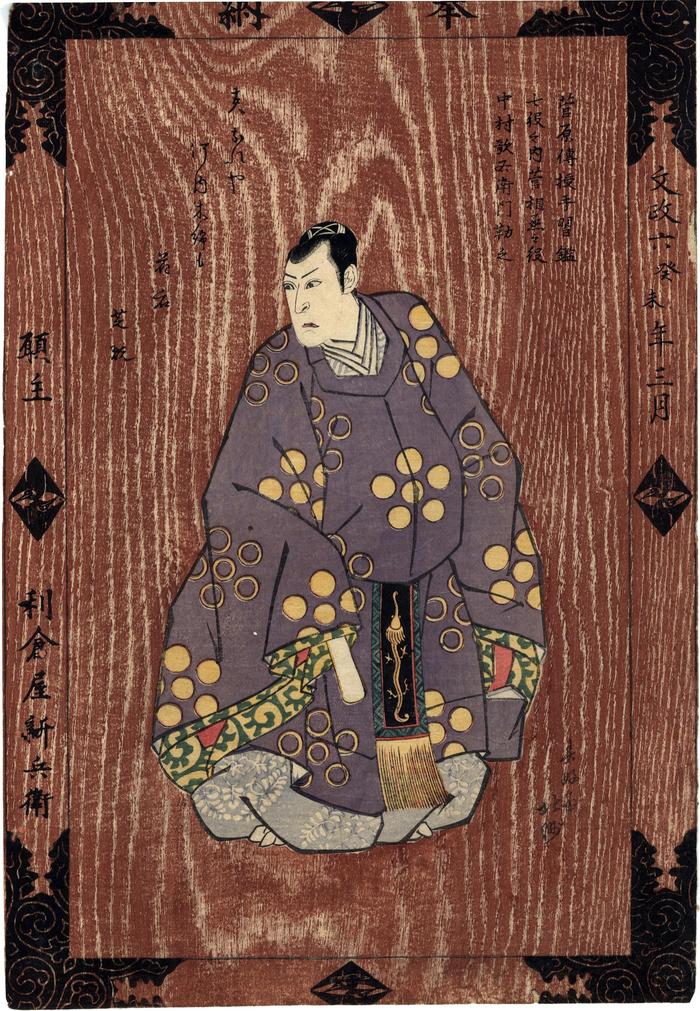Shunkōsai Hokushū (春好斎北洲) (artist ca 1808 – 1832)
Nakamura Utaemon III (中村歌右衛門) as Kan Shōjō (菅丞相) in Sugiwara's Secrets of Calligraphy (Sugawara Denju Tenarai Kagami - 菅原伝授手習鑑)
03/1823
10 in x 14.75 in (Overall dimensions) Japanese color woodblock prints
Signed: Shunkōsai Hokushū (春好斎北洲)
Publisher: Toshikuraya Shinbei (Marks 539)
Waseda University
Lyon Collection - another example
National Museum of Asian Art
Koninklijke Musea voor Kunst en Geschiedenis, Brussel (via Ritsumeikan University) "Nakamura Utaemon III poses in formal courtier robes decorated with stylized plum blossom motifs. As noted in the text written in Chinese characters to the right of the figure, he is portrayed in the role of Kan Shōjō (the Chinese characters for Shōjō are often reversed, as here, but are read the same way) from the kabuki play Sugawara and the Secrets of Calligraphy (Sugawara denju tenari kagami), which was performed at the Kado Theater in Osaka on the fifteenth day of the third month of 1823. The play was originally written in 1746 and is loosely based on the life of the ill-fated aristocrat Sugawara no Michizane (845-903), whose close relationship with the ruling emperor of his day led rivals to maneuver him into exile. Although Utaemon played seven different roles in the play, here he is depicted as Michizane himself.
The wood-grain background resembles an ema, or wooden votive shrine panel... The decoration on the border of the print replicates the lacquered metal supports and studs that embellish and protect such panels, which traditionally are presented as offerings to Shinto shrines. The word hōnō [奉納], or 'offering,' adorns the top of the frame; the characters are separated by the 'double crane' crest of the actor, which appears on the bottom and sides. On the right is the date of the performance: third month of Bunsei 6 (1823); on the left border is the name of the publisher, Toshikuraya Shimbei. Michizane is a particularly appropriate subject for such a votive panel because after his death he was deified and became known commonly as Tenjin. Images of him were widely used as devotional objects.
The haiku is signed Shikan, Utaemon's poetry name. The actor declares that with the arrival of spring he can perform a role that requires hanagoromo (literally, 'flowery robes'), referring to a garment with a white lining and flower motifs on the outside. Cotton manufactured in the Kawachi Province (present-day Osaka area) was particularly strong and was used for making the soles of tabi socks, whic are just barely seen in the image. The poem reads:
haru nare ya
Kawachi momen mo
hanagoromo
Spring has arrived -Quoted from: Masterful Illusions: Japanese Prints in the Anne van Biema Collection, p. 152. The translation of the poem is by John T. Carpenter.
so I don flowery robes
and Kawachi cotton.
****
The background of this print uses the itame mokuhan (板目木版) or imitation woodgrain technique.
"The printing of a wood grain within a print. A wood plank is soaked in water to open up the grain and is then inked and printed to intentionally reproduce the nature of the wood itself."
****
The exact date is in the cartouche along the right side. It reads: Bunsei 6, 3rd month - 文政六癸未年三月. 癸未 indicates that it is the 20th year of the 60 year cycle.
The inscription at the top reads 奉納 which translates as 'dedication'.
****
Illustrated:
1) In Ikeda Bunko, Kamigata yakusha-e shūsei (Collected Kamigata Actor Prints), vol. 1, Osaka, 1998, no. 145.
2) In color in Ukiyo-e Masterpieces in European Collections: Musées Royaux d'Art et d'Histoire, Brussels, vol. 9, Kodansha, 1989, #243.
The example in Brussels is printed in certain areas with metallic inks and would be considered a deluxe edition. That example is not as full a sheet as this one, especially on the left side.
3) in a full-page color reproduction in Masterful Illusions: Japanese Prints in the Anne van Biema Collection, University of Washington Press, 2002, page 153, #50.
****
The use of a faux wooden support with a frame is reminiscent of a Japanese votive painting.
****
The text in the upper right of the print reads starting at the first line:
菅原伝授手習鑑
七役之内菅相丞之役
中村歌右衛門勤之
On the left border it reads: 願主 利倉屋新兵衛
****
There is another copy of this print in the Oita Prefectural Center.
Toshikuraya Shinbei (利倉屋新兵衛) (publisher)
Kyōto-Osaka prints (kamigata-e - 上方絵) (genre)
actor prints (yakusha-e - 役者絵) (genre)
Nakamura Utaemon III (三代目中村歌右衛門) (actor)
